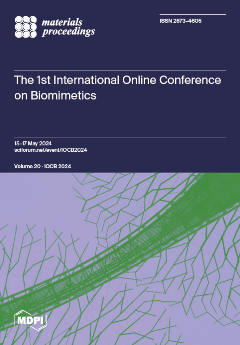Our study considered porous Bouligand structured polymer, comprising polymer fibres with porous spaces between them. These are more complicated structures than the non-porous Bouligand, since the addition of porosity into the material creates a secondary variable besides fibre pitch. There is currently no
[...] Read more.
Our study considered porous Bouligand structured polymer, comprising polymer fibres with porous spaces between them. These are more complicated structures than the non-porous Bouligand, since the addition of porosity into the material creates a secondary variable besides fibre pitch. There is currently no analytical model available to predict the modulus of such materials. Our paper explores the correlation between porosity, polymer fibre pitch angle, and flexural modulus in porous Bouligand structured polymers. Our structures were digitally manufactured using stereolithography (SLA) additive manufacturing methods, after which they were subjected to three-point bending tests. Our aim was to simply and parametrically develop an analytical model that would capture the influences of both porosity and polymer fibre pitch angle on the flexural modulus of the material. Our model is expressed as
, and we derive this by applying non-linear regression to our experimental data. This model predicts the flexural modulus,
, of porous Bouligand structured polymer as a function of both porosity and pitch angle. Here,
is defined as the solid material modulus,
, multiplied by porosity,
and is a linear reduction in the modulus as a function of increasing porosity, while
signifies the polymer fibre pitch angle. This relationship is relatively accurate within the range of 10° ≤
θf ≤ 50°, and for porosity values ranging from
, as supported by our evidence to date.
Full article



